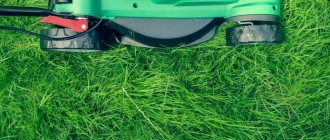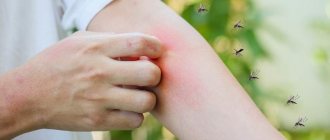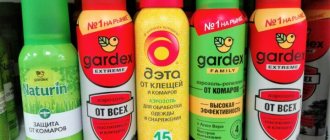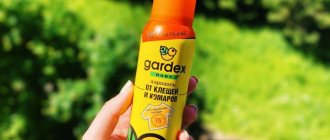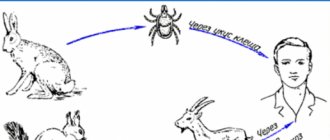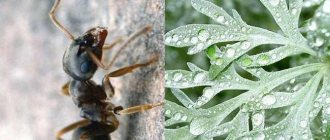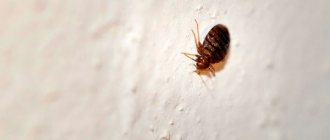From early spring to the end of summer, a huge number of ticks appear in summer cottages. They hide in tall grass or small bushes, creating a threat to both owners and their neighbors. It is necessary to treat your summer cottage for ticks at least twice a year so that new parasites do not have time to move into your territory after the effect of the drug has waned and do not bite the summer residents.
However, it is not always possible to ensure “sterility” at a summer cottage. Ticks can get into the yard with pets, stray cats, dogs, and rodents. The situation is especially dangerous if there is a forest or city park nearby. The fight against ticks is carried out in several ways - by acting directly on them or on animals that spread parasites throughout the land.
The most effective method of control is spring treatment against ticks with poison - insectoacaricidal preparations. The destruction of blood-sucking parasites in open areas occurs within three days, and for about another 2 months the drugs protect the area from re-infection. Anti-tick chemicals are produced in the form of a concentrated emulsion, solution, powder, or checkers.
Protection against ticks using folk remedies involves the use of certain plants and products with a strong, persistent odor. The methods are more aimed at preventing infection than at control, and can be combined with other methods of exterminating pests.
How to find ticks in the country
During the period from April to September, summer residents risk being bitten by ticks in their own summer cottage. To reduce this risk, it is important to be prepared for it, namely:
- Carry out “white flag” tests regularly to know for sure whether there are ticks in the area.
- Protect your pet cats and dogs with special collars and periodically inspect them for ticks.
- During potentially dangerous times of the year, you need to wear tight clothing without leaving access to your body (for example, tuck your trousers into your socks);
- Use repellents.
The “White Flag” is easy to make yourself. To do this, you need to attach a panel of white (light), preferably brushed, fabric to a long stick. Ticks do not crawl on trees; they should be looked for in thick, tall grass and bushes. It is enough to walk slowly with an improvised flag so that the banner touches the grass and bushes. And if there are mites, they can be found on the fabric of the panel.
The verification process involves passing the area several times and applying a “flag” so that it confidently touches the plant surface. You need to walk slowly, avoiding twisting. Every 50 steps it is necessary to check the “flag” for the presence of ticks or plant debris. At the end of the diagnosis, the approximate number of ticks in the entire area of the site will become clear. To avoid getting bitten by a tick, it is important to carefully inspect your clothing before removing it.
Even if no ticks were found the first time, they can still appear on the site. They can be carried by mice, rats, cats, dogs, and pets.
About the pathogen
Argasid ticks and Ixodid ticks are the most dangerous of the 48 known species of these arthropods. The saliva of blood-sucking parasites is a reservoir of infection. It enters the bloodstream when bitten, where the virus multiplies and causes such dangerous infections as:
- Lyme disease;
- Tick-borne encephalitis;
- Q fever;
- Monocytic ehrlichiosis.
Ticks lead a nomadic lifestyle, so cases of infection and carriage of the virus are growing - according to 2022 data, more than 300 thousand people were treated with tick bites. In addition to bites, the tick-borne encephalitis virus is transmitted through the milk of cows and goats.
It is important to know! The peak activity of ticks occurs in the spring-summer season - this is when the area needs to be treated from these insects.
Timing of spring treatment against ticks
The recommended period for carrying out anti-tick treatment of a summer cottage begins in April and ends in early July. This is the time when ticks are most active, which both poses a danger to humans and makes them easy to kill. Direct processing should be carried out in calm weather and with a favorable forecast that does not imply precipitation for several days in advance.
The procedure must be repeated twice a year: during the recommended period and at the end of summer, because this will help reduce the number of ticks in the area when the next spring arrives. Accordingly, treatment must be carried out annually.
Professional approach
If for some reason you cannot treat the area yourself, then call professionals who will deal with the problem as efficiently as possible with all the necessary precautions. After all, who else, if not disinfectors, has experience in fighting. In addition, specialists know perfectly well for which area, under what conditions and what means are best to use. Anti-tick professionals use acaricidal (anti-tick) technology using cold or hot fog generators with powerful insecticides. The cost of processing is approximately as follows:
General rules for treating an area against ticks
If you decide to use insecticidal preparations to kill ticks, then remember several rules. Processing must be done no later than 40 days before harvest. This is necessary so that the chemicals that fall on garden crops have time to be neutralized by rain, watering and plant activity. The danger of poisoning and severe intoxication of the body is high during the first month after treatment. Before the procedure, you should also remove garden furniture and equipment.
On the day of the procedure, be sure to exclude children and pets from the area. Be sure to wear protective clothing. Over the main closed clothing, put on a robe or a special protective suit, a scarf, gloves, and put on high boots or closed shoes. Protect your breathing with a respirator.
After work, wash your clothes, shine your shoes and take a hygienic shower. Avoid chemicals getting into water, especially drinking water. Pay special attention to garden paths, recreation areas and areas near the entrance to the room. Spray any bushes and trees no more than 1.5 meters high. The above makes no sense: there are no ticks there.
After treatment, you can enter the territory without protection after 3 days. During this time, all individuals will die, and the danger of a bite will pass. If you stay in the area immediately after spraying the insecticide, you may not only get poisoned, but be attacked by ticks that have not yet died from the applied poison.
A little about Ixodid, Dermacentor and Hemaphysalis ticks
It’s worth saying right away that ticks sit in tall grass, bushes , crawl out of their wintering places from under last year’s leaves and any other plant debris, and even in the fur of animals, stray or domestic dogs, rats, mice, etc. Such insects are not able to fly or jump, like fleas; they crawl onto the victim or cling to shoes or clothing with their paws, and then crawl to the body.
The inactivity of these parasites is noticeable even in the speed of their movement. They themselves higher than 1.5 m , so in a month they can crawl only about 5 m. But having climbed astride some animal, they are excellent at moving and when they feel a victim nearby, they immediately they begin to crawl towards her. These bloodsuckers are very prolific and leave behind very numerous offspring. On average, a female can lay 3-6 thousand eggs .
Anti-tick medications in a summer cottage
Medilis-Ziper
The professional product is produced in the form of a concentrate. Tick liquid is dissolved in cold water. 5 ml of concentrate is diluted with 1 liter of water. The amount of the finished solution is calculated based on the area. 50 ml of concentrated preparation is enough to kill ticks on 10 acres. It is recommended to treat the garden, lawn, and yard in early spring, late autumn, or 3 days before a family or company visit to nature is planned. The effect lasts for 40 days.
Ram
Insectoacaricidal drug with a wide spectrum of action. The active ingredient is permethrin. The solution is prepared immediately before treatment. For 1 liter of cool water, 2.5 ml of concentrate is required. 100 liters of the prepared solution is enough to poison ticks on 1 hectare of area. Taran is effective after treatment for about 50 days.
Dobrokhim-Fos
You can protect yourself from ticks in your dacha using a proven domestic product. The concentrated insecticide contains an active substance and a synergist to enhance the effect. A 50 ml bottle is enough to poison ticks on 100 sq. m. The price of the drug is 390 rubles. For 1 liter of cold water, 10 ml of concentrate is consumed. The maximum effect lasts 15 days.
Quiet evening
Smoke bomb against blood-sucking insects, including ticks. Easy to use, does not require complex preparatory manipulations. The active substance is in a tin jar, there is also peat there. After lighting the fuse, the saber begins to smolder, releasing toxic smoke into the air. The checker should be installed 10 m from the place that needs to be protected, in the direction of the wind.
The advantage of the drug is the passive participation of the person; the treatment is carried out independently within 2 hours. Toxic particles settle on the surface of grass, leaves of bushes, trees, the radius of action is 250 square meters. m. Properties last for about a month. You are allowed to come to nature 3 days after disinfestation.
Cifox, Doctor Klaus, Ixoder, Cypermethrin are also effective. Chemical treatments for ticks are highly effective, but not safe, so many people prefer to use less effective methods of control.
Fighting methods
Ixodid ticks not only bite painfully and leave behind inflamed blisters, but they are also carriers of dangerous diseases, including tick-borne encephalitis and borreliosis. It is recommended that everyone avoid meeting them. In the absence of an epidemic or threat of infection, safe methods of control are used - they mow the grass on the site in a timely manner, do not allow overgrowth, trim the branches of bushes, the crowns of young trees to a height of more than 50 cm from the ground. Create unfavorable development conditions for pests.
However, it is not always possible to ensure “sterility” at a summer cottage. Ticks can get into the yard with pets, stray cats, dogs, and rodents. The situation is especially dangerous if there is a forest or city park nearby. The fight against ticks is carried out in several ways - by acting directly on them or on animals that spread parasites throughout the land.
On a note!
It is recommended to fence the area with a fence to prevent the appearance of wild animals, stray dogs and cats. Use rodent traps or periodically place poisonous bait.
The most effective method of control is to treat the area against ticks with poison - insectoacaricidal preparations. The destruction of blood-sucking parasites in open areas occurs within three days, and for about another 2 months the drugs protect the area from re-infection. Anti-tick chemicals are produced in the form of a concentrated emulsion, solution, powder, or checkers.
Protection against ticks using folk remedies involves the use of certain plants and products with a strong, persistent odor. The methods are more aimed at preventing infection than at control, and can be combined with other methods of exterminating pests.
Costs of drugs when treating ticks
Almost all instructions for acaricidal agents recommend fluid consumption at the rate of 1 liter of working solution/100 sq.m. (one hundred square meters). For a household consumer, such a calculation is ineffective. The fact is that the instructions are aimed at professionals who use either motorized sprayers or ULV generators. In them, the liquid is supplied in small droplets and 1 liter per hundred square meters is quite enough.
When treated with a regular garden sprayer, be it pump or hydraulic (and this is what you have to use in everyday life), the liquid is sprayed in large drops and the emulsion is consumed faster. One liter of solution is not enough to evenly treat 1 hundred square meters. The actual consumption is from 3 to 5 liters per 100 sq.m. How, then, can you increase processing efficiency and not spend too much?
Maintain uniformity when applying the product (50 ml/sq.m.). At the same time, make sure that the liquid does not spill, and the applied emulsion does not flow from the leaves into the soil, taking the drug with it. Small, uniform droplets provide the best coverage of the surface being treated, so adjust the nozzle pattern accordingly. Otherwise, the treatment may turn out to be of poor quality and uneconomical, and the product may be wasted.
Calling a specialist is much easier.
The company the owner contacts will have everything necessary and will select favorable weather conditions for processing. The owner of the site only needs to pay and agree on the choice of means that will be used to treat the site. The approximate cost of professional processing is determined by the size of the site and its distance from the city. Basically, companies require 600 rubles from 1 hundred square meters and about 400 rubles from 40 hundred square meters, then, as a rule, the price is negotiable. In this case, the owner spends money but saves time. In contact with
